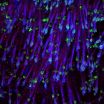(Press-News.org) MANHATTAN, Kansas — Several Kansas State University researchers were essential in helping scientists assemble a draft of a genetic blueprint of bread wheat, also known as common wheat. The food plant is grown on more than 531 million acres around the world and produces nearly 700 million tons of food each year.
The International Wheat Genome Sequencing Consortium, which also includes faculty at Kansas State University, recently published a chromosome-based draft sequence of wheat's genetic code, which is called a genome. "A chromosome-based draft sequence of the hexaploid bread wheat genome" is one of four papers about the wheat genome that appear in the journal Science.
The genetic blueprint is an invaluable resource to plant science researchers and breeders, said Eduard Akhunov, associate professor of plant pathology and a collaborator with the International Wheat Genome Sequencing Consortium.
"For the first time, they have at their disposal a set of tools enabling them to rapidly locate specific genes on individual wheat chromosomes throughout the genome," Akhunov said. "This resource is invaluable for identifying those genes that control complex traits, such as yield, grain quality, disease, pest resistance and abiotic stress tolerance. They will be able to produce a new generation of wheat varieties with higher yields and improved sustainability to meet the demands of a growing world population in a changing environment."
Although a draft, the sequence provides new insight into the plant's structure, organization, evolution and genetic complexity.
"This is a very significant advancement for wheat genetics and breeding community," Akhunov said. "The wheat genome sequence provides a foundation for studying genetic variation and understanding how changes in the genetic code can impact important agronomic traits. In our lab we use this sequence to create a catalog of single base changes in DNA sequence of a worldwide sample of wheat lines to get insights into the evolution and origin of wheat genetic diversity."
Akhunov, Shichen Wang, a programmer and bioinformatics scientist in plant pathology, and Jesse Poland, assistant professor of plant pathology, collaborated with the International Wheat Genome Sequencing Consortium to order genes along the wheat chromosomes.
Other Kansas State University researchers in the department of plant pathology involved include Bikram Gill, university distinguished professor and director of the Wheat Genetics Resource Center, and Bernd Friebe, research professor, who developed genetic material that was essential for obtaining the chromosome-based sequence of the wheat genome.
A second paper in Science details the first reference sequence of chromosome 3B, the largest chromosome in common wheat.
"The wheat genome only has 21 chromosomes, but each chromosome is very big and therefore quite complicated," Akhunov said. "The largest chromosome, 3B, has nearly 800 million letters in its genetic code. This is nearly three times more information than is in the entire rice genome. So trying to sequence this chromosome — and this genome — end-to-end is an extremely complicated task."
In order to analyze the vast amount of genetic information, researchers used a technique called shotgun sequencing. This divided the wheat genome into chromosomes and then split each chromosome into smaller segments. Chromosomal segments were analyzed by short gene sequences and overlapping sequences were stitched together with computer software.
The chromosome-based daft sequence the critical step before the full wheat genome is sequenced, Akhunov said. The sequencing approach developed for the 3B chromosome can now be applied for sequencing the remaining chromosomes in wheat. The consortium estimates the full genome sequence will be available in three years.
The research is funded by the U.S. Department of Agriculture's National Institute of Food and Agriculture.
"Wheat is a staple source of food for the majority of the world. As the global population continues to rapidly increase, we will need all the tools available to continue producing enough food for all people in light of a changing climate, diminishing land and water resources and changing diets and health expectations," said Sonny Ramaswamy, director of USDA's National Institute of Food and Agriculture and a former Kansas State University faculty member. "This work will give a boost to researchers looking to identify ways to increase wheat yields."
INFORMATION: END
Scientists complete chromosome-based draft of the wheat genome
2014-07-17
ELSE PRESS RELEASES FROM THIS DATE:
Ultrafast X-ray laser sheds new light on fundamental ultrafast dynamics
2014-07-17
MANHATTAN, Kansas — Ultrafast X-ray laser research led by Kansas State University has provided scientists with a snapshot of a fundamental molecular phenomenon. The finding sheds new light on microscopic electron motion in molecules.
Artem Rudenko, assistant professor of physics and a member of the university's James R. Macdonald Laboratory; Daniel Rolles, currently a junior research group leader at Deutsches Elektronen-Synchrotron in Hamburg, Germany, who will be joining the university's physics department in January 2015; and an international group of collaborators ...
No evidence that California cellphone ban decreased accidents, says Colarado University Boulder researcher
2014-07-17
In a recent study, a researcher at the University of Colorado Boulder found no evidence that a California ban on using hand-held cellphones while driving decreased the number of traffic accidents in the state in the first six months following the ban.
The findings, published in the journal Transportation Research Part A: Policy and Practice, are surprising given prior research that suggests driving while using a cellphone is risky. For example, past laboratory studies have shown that people who talk on a cellphone while using driving simulators are as impaired as people ...
Peering into giant planets from in and out of this world
2014-07-17
Lawrence Livermore scientists for the first time have experimentally re-created the conditions that exist deep inside giant planets, such as Jupiter, Uranus and many of the planets recently discovered outside our solar system.
Researchers can now re-create and accurately measure material properties that control how these planets evolve over time, information essential for understanding how these massive objects form. This study focused on carbon, the fourth most abundant element in the cosmos (after hydrogen, helium and oxygen), which has an important role in many types ...
Help wanted: Principals who love change
2014-07-17
DALLAS (SMU) – Training principals for new roles is key to U.S. Department of Education school reforms, according to a new report by SMU researchers. But insufficient training and support for principals to meet the new expectations is leading to a leadership crisis. Twenty percent of newly minted principals leave the profession after two years and seasoned professionals are opting for early retirement.
Education researchers Lee Alvoid and Watt Lesley Black Jr. examine school districts at the forefront of supporting and training effective principals in their report "The ...
CNIO researchers discover a gene that links stem cells, aging and cancer
2014-07-17
An organism is healthy thanks to a good maintenance system: the normal functioning of organs and environmental exposure cause damage to tissues, which need to be continuously repaired. This process is not yet well understood, but it is known that stem cells in the organs play a key role, and that when repair fails, the organism ages more quickly. Researchers from the Spanish National Cancer Research Centre (CNIO) have "discovered one of the key genes that make up the maintenance mechanism for tissues" says Miguel Foronda, the first author of the manuscript.
The study ...
First ab initio method for characterizing hot carriers
2014-07-17
One of the major road blocks to the design and development of new, more efficient solar cells may have been cleared. Researchers with the Lawrence Berkeley National Laboratory (Berkeley Lab) have developed the first ab initio method – meaning a theoretical model free of adjustable or empirical parameters – for characterizing the properties of "hot carriers" in semiconductors. Hot carriers are electrical charge carriers - electrons and holes – with significantly higher energy than charge carriers at thermal equilibrium.
"Hot carrier thermalization is a major source of ...
Untangling spider's webs
2014-07-17
For decades, the story of spider evolution went like this: As insects became more and more diverse, with some species taking to the skies, spiders evolved new hunting strategies, including the ability to weave orb-shaped webs to trap their prey.
From that single origin, the story goes, orb-weaver spiders diverged along different evolutionary paths, leading to today, where several species weave similar – though not identical – webs.
It's a good story, but there's just one problem – Harvard scientists now know it's not true.
The largest-ever phylogenetic study of ...
Eye movements reveal difference between love and lust
2014-07-17
Soul singer Betty Everett once proclaimed, "If you want to know if he loves you so, it's in his kiss." But a new study by University of Chicago researchers suggests the difference between love and lust might be in the eyes after all.
Specifically, where your date looks at you could indicate whether love or lust is in the cards. The new study found that eye patterns concentrate on a stranger's face if the viewer sees that person as a potential partner in romantic love, but the viewer gazes more at the other person's body if he or she is feeling sexual desire. That automatic ...
Atlantic salmon also show capacity to adapt to warmer waters
2014-07-17
Populations of Atlantic salmon have a surprisingly good capacity to adjust to warmer temperatures that are being seen with climate change, a group of scientists at the University of Oslo and University of British Columbia have discovered. The finding about Atlantic species adds to recent UBC-supported research on heat tolerance of Pacific salmon.
The new study, a collaboration between Norwegian and Canadian researchers, was recently published in Nature Communications. Funded by the Norwegian Research Council, it addressed questions around how climate change might affect ...
Eating lean beef daily can help lower blood pressure
2014-07-17
Contrary to conventional wisdom, a growing body of evidence shows that eating lean beef can reduce risk factors for heart disease, according to recent research by nutritional scientists.
"This research adds to the significant evidence, including work previously done in our lab, that supports lean beef's role in a heart-healthy diet," said Penny M. Kris-Etherton, Distinguished Professor of Nutrition, Penn State. "This study shows that nutrient-rich lean beef can be included as part of a heart-healthy diet that reduces blood pressure, which can help lower the risk for cardiovascular ...




